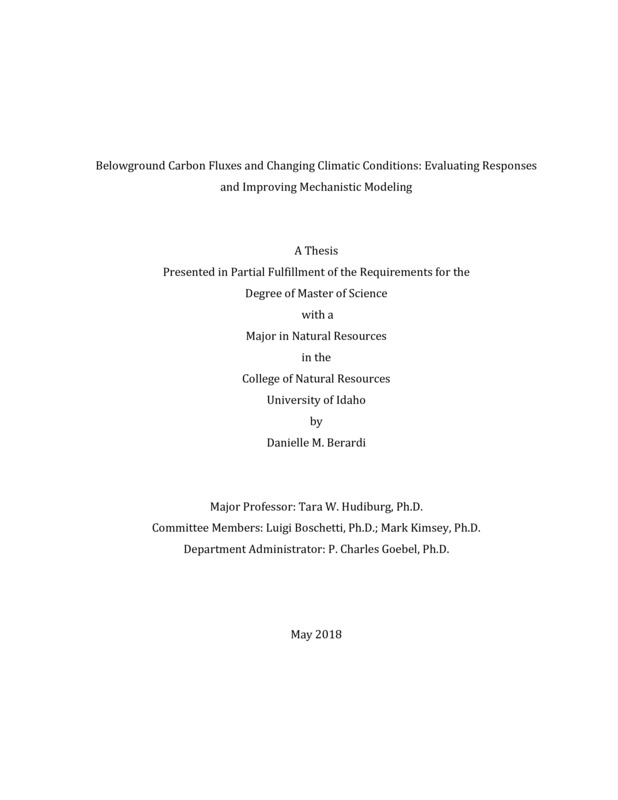Belowground Carbon Fluxes and Changing Climatic Conditions: Evaluating Responses and Improving Mechanistic Modeling
Berardi, Danielle. (2018-05). Belowground Carbon Fluxes and Changing Climatic Conditions: Evaluating Responses and Improving Mechanistic Modeling. Theses and Dissertations Collection, University of Idaho Library Digital Collections. https://www.lib.uidaho.edu/digital/etd/items/berardi_idaho_0089n_11257.html
- Title:
- Belowground Carbon Fluxes and Changing Climatic Conditions: Evaluating Responses and Improving Mechanistic Modeling
- Author:
- Berardi, Danielle
- Date:
- 2018-05
- Keywords:
- Ecosystem Modeling Soil Respiration
- Program:
- Natural Resources
- Subject Category:
- Ecology
- Abstract:
-
Forests have an important role in the global carbon cycle, are a known regulator of climate, and are valued globally for the ecosystem services they provide to society. It is critical to improve our understanding about the exchange of carbon dioxide between forest ecosystems and Earth’s atmosphere. Specifically, there is a need for improved mechanistic understanding of the component fluxes of soil respiration (Rs): autotrophic respiration (Ra; roots and associated mycorrhizae) and heterotrophic respiration (Rh; free-living soil microbes and soil fauna involved in decomposition). We examined the responses and relative contributions of these components to manipulated soil moisture. We found that heterotrophic respiration significantly responds to moisture additions regardless of season while autotrophic respiration did not. We also found that widely used and accepted methods for survey measurements (versus automated) were not sufficient to build relationships with abiotic factors for diurnal, monthly, and annual scaling, thus eliminating commonly used gap-filling procedures. Because survey measurements are often used to validate model results, it is critical that they be done over varying time periods (some diurnal) and be paired with automated measurements.
When comparing our experimental data to modeled results, we found that DayCent, a daily time-step process-based biogeochemical model, underestimates annual heterotrophic respiration by several magnitudes compared to our temperate mixed conifer forest site. This is likely because DayCent, like most traditional ecosystem models, simulates decomposition through first order kinetics which inadequately represents microbial processes. Recent research has found that including microbial mechanisms explains 20 percent more spatial heterogeneity. We manipulated the DayCent heterotrophic respiration model to include a more mechanistic representation of microbial dynamics and compared the new model with our continuous and survey observations. By using a more representative and fully calibrated model of soil carbon dynamics, we are better able to predict feedbacks between climate and soil carbon pools to inform decisions and provide benefits to society through improvements to ecosystem modeling.
- Description:
- masters, M.S., Natural Resources -- University of Idaho - College of Graduate Studies, 2018-05
- Major Professor:
- Hudiburg, Tara
- Committee:
- Boschetti, Luigi; Kimsey, Mark
- Defense Date:
- 2018-05
- Identifier:
- Berardi_idaho_0089N_11257
- Type:
- Text
- Format Original:
- Format:
- application/pdf
- Rights:
- In Copyright - Educational Use Permitted. For more information, please contact University of Idaho Library Special Collections and Archives Department at libspec@uidaho.edu.
- Standardized Rights:
- http://rightsstatements.org/vocab/InC-EDU/1.0/

